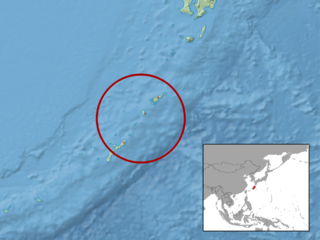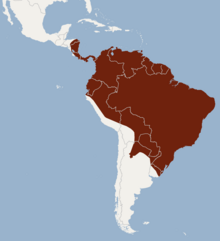
Natterer's bat is a European vespertilionid bat with pale wings. It has brown fur tending to greyish-white on its underside. It is found across most of the continent of Europe, parts of the Near East and North Africa. It feeds on insects and other invertebrates which it catches on the wing or pursues on the ground.

The little red flying-fox is a megachiropteran bat native to northern and eastern Australia. The species weighs about half a kilogram, one US pound, and is the smallest species of Pteropus in mainland Australia. P. scapulatus occurs at the coast and further inland, camping and flying to the tropical to temperate regions that provide them with an annual source of nectar. They exhibit an unusual method of obtaining drinking water during dry periods, skimming a stream's surface to gather it onto their fur while they are in flight.

The silver-tipped myotis is a species of mouse-eared bat found in a range of lowland habitats in the Americas.

The velvety myotis, is a species of vesper bat from South America.

The dark long-tongued bat is a species of bat from South and Central America. It was formerly considered monotypic within the genus Lichonycteris, but is now recognized as one of two species in that genus, along with the pale brown long-nosed bat. It is small species of bat, with adults weighing 6–11 g (0.21–0.39 oz) and having a total length of 46–63 mm (1.8–2.5 in).

The Atacama myotis is a species of vesper bat in the family Vespertilionidae. It is found in Chile and Peru, an example ecoregion of occurrence being the Chilean matorral.

Findley's myotis is a species of vesper bat. It is found only on the Tres Marías Islands off the west coast of Mexico.

The hairy-legged myotis is a species of mouse-eared bat. It is found from southern Tamaulipas in Mexico, through much of Central America and across northern South America as far east as Trinidad. Further south, it is found along the foothills of the Andes as far south as northern Argentina.

The eastern small-footed bat is a species of vesper bat. It can be found in southern Ontario and Quebec in Canada and in mountainous portions of the eastern United States from New England to northern Georgia, and westward to northern Arkansas. It is among the smallest bats in eastern North America and is known for its small feet and black face-mask. Until recently, all North American small-footed Myotis were considered to be "Myotis leibii". The western population is now considered to be a separate species, Myotis ciliolabrum. The Eastern small-footed bat is rare throughout its range, although the species may be locally abundant where suitable habitat exists. Studies suggest white-nose syndrome has caused declines in their populations. However, most occurrences of this species have only been counted within the past decade or two and are not revisited regularly, making their population status difficult to assess. Additionally, most bat populations in the Eastern U.S. have been monitored using surveys conducted in caves and mines in the winter, but Eastern small-footed bats hibernate in places that make them unlikely to be encountered during these surveys. Perhaps as a result, the numbers of Eastern small-footed bats counted in winter tend to be low and they are relatively variable compared to other species of bats. Many biologists believe the species is stable, having declined little in recent times, but that it is vulnerable due to its relatively restricted geographic range and habitat needs.

The frosted myotis is a species of vesper bat. It is found only in Japan.

The long-legged myotis is a species of vesper bat that can be found in western Canada, Mexico, and the western United States.

Welwitsch's bat also known as Welwitsch's mouse-eared bat or Welwitsch's myotis is a species of vesper bat native to Africa.

The Yanbaru whiskered bat(Myotis yanbarensis) is a species of vesper bat in the genus Myotis.
The southern forest bat is a vespertilionid bat found in Australia.

The Ethiopian epauletted fruit bat is a species of megabat in the family Pteropodidae. It is found in Burundi, Chad, Republic of the Congo, Democratic Republic of the Congo, Eritrea, Ethiopia, Kenya, Malawi, Mozambique, Nigeria, Rwanda, Sudan, Tanzania, and Uganda. Its natural habitats are dry savanna and moist savanna. It is threatened by habitat destruction.

The Daubenton's free-tailed bat or Daubenton's winged-mouse bat is a species of bat in the family Molossidae. It is found in Central African Republic, Democratic Republic of the Congo, Ivory Coast, and Senegal. Its natural habitats are subtropical or tropical dry forests and dry savanna. It is threatened by habitat loss.

The black-bearded flying fox is an endangered species of megabat in the genus Pteropus. It is endemic to Indonesia, found on the islands of Ambon, Buru, Seram, Banda, and Yamdena. Currently considered monotypic, it formerly included the Aru flying fox and Kei flying fox as subspecies.

The long-fingered bat is a carnivorous species of vesper bat. It is native to coastal areas around the Mediterranean Sea, as well as a few patches of land in western Iran. Due to the fact that its population is in decline, it is listed as Vulnerable on the IUCN Red List since 1988.
The Taiwan broad-muzzled bat or Taiwan broad-muzzled myotis is a species of vesper bat found in Taiwan.

The long-tailed myotis is a species of vesper bat found in northern and eastern Asia.



















